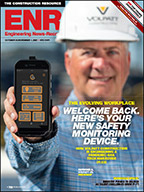
A handheld device, ikeGPS, is finding new fans in the U.S. as it performs the work of a digital compass, a camera, a laptop and a laser range-finder. Created by Surveylab, Wellington, New Zealand, it is saving utility companies hours of data collection and entry work and appears to have the potential to do even more.
"We're seeing a 30% reduction in time spent collecting data," says Ed Gray, director of program development for CN Utility Consulting, Sebastopol, Calif. "I've never seen anything like this." The device has been out for years, but Altus Positioning Systems, Torrence, Calif., recently began distributing it in North America with the option of a GNSS receiver-antenna for more accuracy.
"The ike is accurate within 0.6 meters but can be coupled with our sensitive receiver to get centimeter-level accuracy," says Neil Vancans, president, Altus Position Systems.
Gray says utility companies deploy the ikeGPS to measure the distance between utility lines and poles from up to 1,000 meters away. However, he says it can do more.
"I can take a tree and collect specific data, like height and width," he says. "Then, I can rotate it in the software to see which way it will lean." This lean measurement determines if the tree is a hazard to utility lines. "It can also replace expensive LiDAR when making replacement drawings for the utility lines," says Gray.
Also, ikeGPS can quickly collate data, says Gray. For about $6,000, "it's cheaper and easier than buying each worker all the equipment needed to do what the ikeGPS does alone," he says. Pike Research says the utility industry will spend $3.7 billion on GIS utility tools and services by 2017. Gray says ikeGPS will save the industry a bundle.



Post a comment to this article
Report Abusive Comment